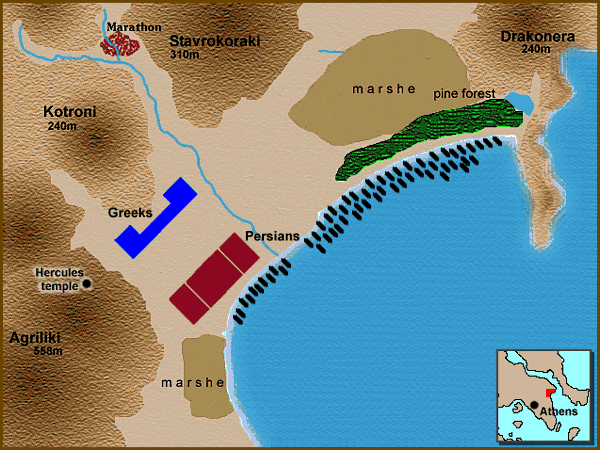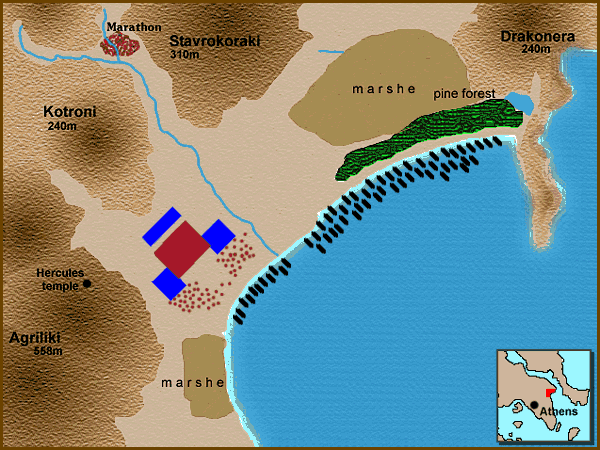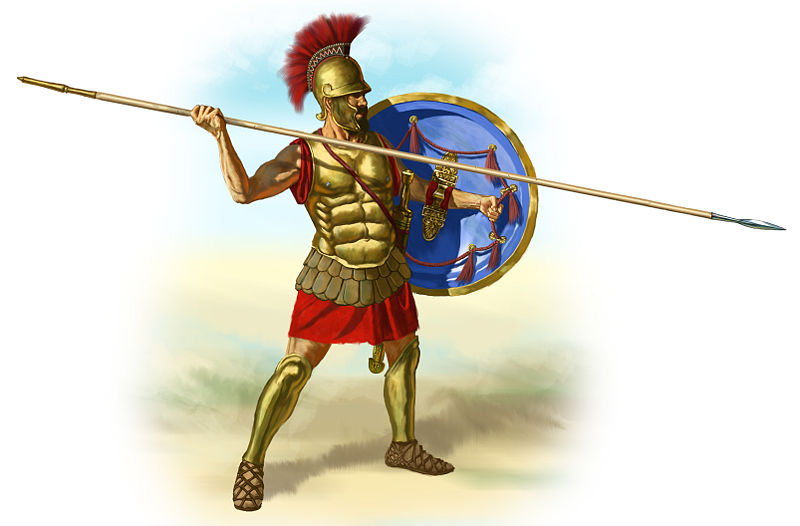[World Battles] Marathon 490 B.C
 •
by
•
by Terron de azucar
Sorry for my bad english
Previous number
Kadesh (1285 B.C)
http://goo.gl/d9R9iZ
The organization and the efficiency of the greek strategy was proven in the Battle of Marathon against the imposing persian expedition of the general Datis, that despite his superiority in number, it was blocked by the hoplites of Athens and Plataea in a battle which become legendary.
Cavalry: 2.000 - - - - - Plataeans: 1.000
Archers: 2.000 - - - - - - - - - - - - - - - - -
Ships: 600 - - - - - - - - - - - - - - -
😛
At the beginning of September, a persian army of about 25.000 men embarked in Cilicia on a 600 ships that went to Greece, they conquered a good number of islands of the archipelago of the Cyclades, that are situated between the greek peninsula and Anatolia, and that became important strategic point. On the Euboea island, the persian won the resistance of the city of Eretria, that was wiped out and his inhabitants became a sclaves.


The Datis navy went to Athens until it lingers (under advice from the athenian Hippias, who had deserted from his ranks to collaborate with the persians) in the proximities of Marathon, a city placed in a plain on the greek east coast.
Meanwhile, the athenians, that they had already seen the persian ships approaching, recruited an army capable of face the persians.
Between the athenian heads beyond the supreme commander, Callimachus, was standing out Miltiades, who was part of the noble family of the Philaidae and he had served to the enemy ranks in his youth.
The structure of the athenian command structure decided that the army should be separated into ten contingents according to the ten tribes of the city and that every contigent was remaining under the control of his own head. Meanwhile, the supreme command was submitted to the polemarch. In principle, the supreme military authority was going to be rotating, but when the circumstances have turned because of the persian invasion, Miltiades was chosen to command the alliance between athenians and plataeans.

While the athenian army was heading for Marathon, Miltiades sent his faster soldier, Pheidippides, to look for more reinforcements in Sparta. But Pheidippides arrived at its destination when the religious ceremonies were celebrated that the spartans realized traditionally before they leave for the battle and it prevented them from engage in battle until the next full moon.
On September 11, the athenians arrived at the surrounding areas of Marathon, blocking the way towards Athens and they observed the persian army from a hill, that was among his detachments with an important cavalry and archers highly trained. The contemplation of the persian army was so striking that some athenians generals gave up to dive into a battle. For a few days, Miltiades observed the enemy and he remained rather hesitant to take any initiative as he expected the spartan reinforcements. Furthermore, it took a few days for the persians to engage any combat action.
On September 17, two squads entered the fray. The persian tactical schematic provided that the heavy infantry will be in the centre, supported by the heavy and light cavalry on the flanks, while the archers was in the rear. The front line of the persian army was very extensive; that led the greeks to arrange his lines in such a manner that covering as possible the enemy front of assault, but without depriving the flanks.
The persians archers opened hostilities shooting arrows at the greeks and, after a gap of about two hours, the invasors started moving to the center of formation formed by athenians and plataeans, who were waiting for the enemy at the mouth of the valley.
According to Herodotus (main source for study the persian wars), the greeks launched the assault, but it seems impossible that the heavy infantry, that was carrying weapons and armors, would not have been able to cross almost one kilometre and half (the distance that was separating them from the persians) without getting exhausted. It is more believable that the greeks waited the attack, studying the enemy’s movements before taking the initiative.
According to Herodotus (main source for study the persian wars), the greeks launched the assault, but it seems impossible that the heavy infantry, that was carrying weapons and armors, would not have been able to cross almost one kilometre and half (the distance that was separating them from the persians) without getting exhausted. It is more believable that the greeks waited the attack, studying the enemy’s movements before taking the initiative.
According to Herodotus (main source for study the persian wars), the greeks launched the assault, but it seems impossible that the heavy infantry, that was carrying weapons and armors, would not have been able to cross almost one kilometre and half (the distance that was separating them from the persians) without getting exhausted. It is more believable that the greeks waited the attack, studying the enemy’s movements before taking the initiative.

The persians believed to win because because they hoped their archers (They didn’t count on the greeks troops were protected with shields that allowed them to defend against the enemy spears and arrows drawing a parable in the aire) and because the infantry that rode out to meet troops of Miltiades at the mouth of the valley compromised the room for manoeuvre of the greek cavalry.
But Miltiades, after been forced to neutralize temporarily the persian cavalry, waited until the enemy were a less than 200 meters to send in a full strike. The center of the greek formation, under the command of Aristides and Themistocles, was forced to keep the tremendous pressure and to expose to losing area while the flanks were supporting the confrontation against the persians.
The men of Datis couldn't dismast the flanks and they gathered to center while it looked like the athenians were withdrawing. Miltiades gave the order to counter-attack suddenly. The main battle was enclosed between the flanks and the hellenic front, according to scheme of combat that was repeated in Cannae three centuries later, when the roman legions were rounded and massacred by the carthaginian army that was outnumber.
Retreating, the persians went to his ships, giving up to sustain the struggle and avoiding losses. Meanwhile, the greeks were reorganized and they were feasting the victory. The battle resulted 7.000 persians casualties and 192 greeks casualties; moreover, 7 ships anchored near the coast were lost.
Miltiades left Arístides with a section of the army guarding the booty and the victims and, in full swing, he returns to Athens with about 8.000 men to stop in the south the attack of the persians that could have landed in Falero, that was a port near Attica capital. Datis indeed arrived at Falero, but he resigned to land and to do battle when he saw that city was well protected.
A few days later, the persians retired for return to Anatolia. Meanwhile, when the greek fallen had not yet been buried, the spartans reinforcements arrived, that in three days, they crossed about 240 kilometres to arrive at the battlefield.

The greek armament and the phalanx
At Marathon (and over the next two centuries), the greek armament proved its superiority. The persian warrior wore uniform of cloth and leather, it wasn’t very strong against the sword or the spear of a greek hoplite who, on the contrary, was protected with a shell of bronze and a wooden shield.
Despite the fact that the greeks had archers and a some units of spearmen, their presence in the battle was considerably fewer than other detachments that formed part of the persian army or other nations of the Near East.

The army of the archaic greeks polis fought in battles with an infantry in square formation of 16 soldiers in a row and organized in columns. This formation of 256 soldiers could double and became a rectangle of 32x16.
In the epoch in that the Iliad was written, a stronger formation emerged. In a portion of the poem the phalanx was reinforced with shields, spears inclined forward and vizored helmets in order to contain the trojan charge. In this complex tactical unit, the square was multiplied by 16, and it was formed by 4.096 hoplites, armed with shell, helmet, shield, sword and a spear of up to 5 meters with which those that formed the last row could attack the enemy that attack the first.
The spartan phalanx, for their part, was lighter and it didn’t exceed 900 men. It was suitable for fight against an enemy that attack with the same formation (only logical in the fights against other polis) In that case, the cavalry and the infantry (equipped with shield and shorter spear) was added to the flanks and to the rear, and other division with arch and javelin that open the road to the rest of the formation.

Pheidippides, the hero of Marathon
Herodotus, author of the most detailed description of the battle of Marathon, tells that a government official who transported messages (an hemerodrome, a men capable of through the fields for an entire day or more) was sent by the military command of his city, Athens, to ask for help to Sparta after the taking of Eretria.
Pheidippides arrived at the city after a day’s march and that ends the story of Herodotus.
Nevertheless, the legend sprang from this fact, that tells that the emissary Pheidippides (a name that means “who competes against the horse”), who was described as a young participant in the battle of Marathon who offered to bring the notice of the victory to Athens. For this purpose, he would have travelled 42 kilometres from the battlefront to the city and, after confirm the good news, he died of exhaustion. In his honor, in the Olympic Games, the Athletic speciality of marathon is practised, a career that its covers 42,195 kilometres.

Next number: Thermopylae 480 B.C
[World Battles] Marathon 490 B.C
http://goo.gl/2GVmQY


Comments
Run bitch, run!!
Si vas a seguir con esta temática en España tenemos muchísimas batallas epicas dignas de mención.
So cray cray in a okay way.
estabas alli tu para contar los muertos no ? 😃
Los contó Herodoto 😛
v
He dejado de leer para no estropearme el poco inglés que tengo.
Esclavos no es sclaves, es slaves.
Y de gramática fatal. Quema esa página donde hayas hecho la traducción.
sin versión en español, paso.
voted. nice moving images. oreo